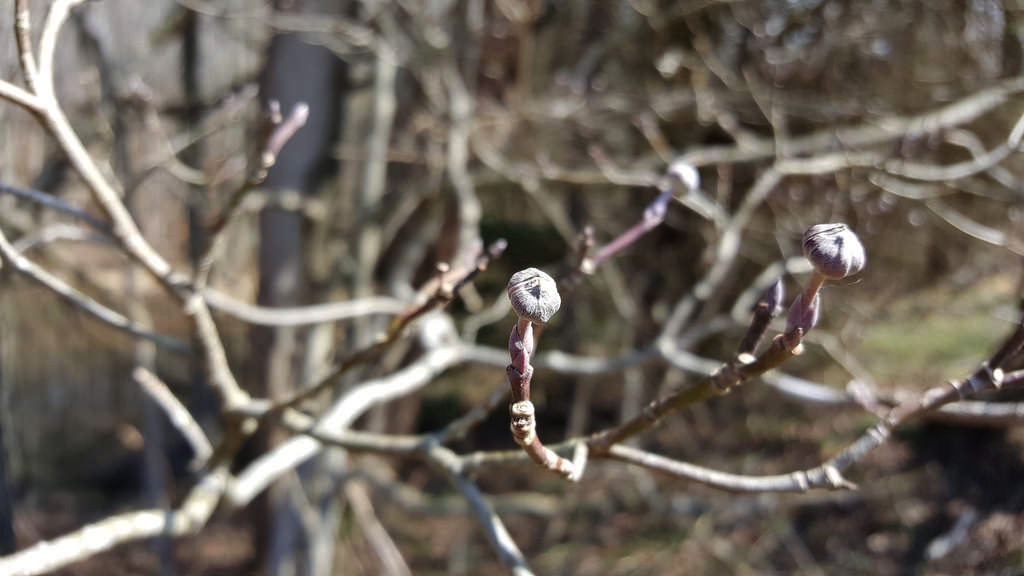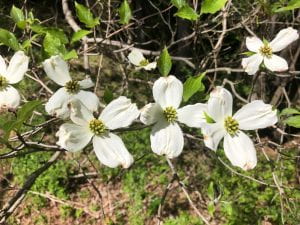Flowering Dogwood
Cornus florida L.
Description
Flowering dogwood (family Cornaceae) is a deciduous, understory tree that typically reaches a height of 30 to 40 ft with a maximum height of 55 ft and a diameter of 8 to 16 in¹. In the understory it has a flat top crown with horizontal branches³. It has an extremely shallow rooting system that accounts for its distribution in moist sites¹. Trees may live up to 125 years, but rapid growth stops after 30 years¹. Leaves are oppositely attached, oval with smooth or wavy margins, a long pointed tip and lateral veins that bend along the margin. In the fall the leaves turn scarlet to magenta. Flowering is in April before leaves mature. Its flowers are inconspicuous but are bunched above large, showy white bracts up to 4 inches across making this perhaps the most attractive tree in the Eastern Deciduous Forest. The fruits turn bright red in the early fall.

Bark of flowering dogwood. M Gray, Maryland Plant Atlas²

Winter flowering buds of flowering dogwood. B. Hubick, Maryland Plant Atlas²
Flowers of flowering dogwood. @ J, Hull, TU

Fruits of flowering dogwood. W. Lonbotom, Maryland Plant Atlas²
Distribution
Flowering dogwood is distributed throughout the Eastern United States from Maine to Northern Florida and Southern Michigan to East Texas¹. It is found in all counties of Maryland². Its habitat is on well drained, moist soils and is not found on ridge tops or in wetlands.

Native range of flowering dogwood. Wikipedia8
Wildlife Importance
The fruits of flowering dogwood are high in fats and calcium and are eaten by 36 species of birds including turkey and by numerous mammals including chipmunks, bears, deer, foxes and rabbits. It serves as a larval host for the Spring Azure butterfly³.
Economic Importance
Flowering dogwood is widely used in horticulture¹. Dogwood was used as a shuttle for textile weaving and for making golf club heads and mallets1,7.
Threats
Flowering dogwood is susceptible to dogwood anthracnose (Discula destructive), a fungus introduced in the 1970s in the Northeast US and is quickly spreading. The disease results in the death of the tree. A number of resistant varieties are available in the horticultural trade5.
Interesting Facts
- More that 20 cultivars are sold in the horticultural trade¹.
- Indians used the bark and roots for a remedy for fevers; during the Civil War, the bark was used as a substitute for quinine to treat malaria³.
- Indians used portions to treat various maladies including measles, worms, diarrhea and wounds4.
- The common name dogwood comes from the use of the stems as skewers, once known as dogs6.
- Dogwood is the state tree of Missouri and Virginia.
References
- USDA-Forest Service Silvics, Vol. 2 Hardwoods: Cornus florida
- Maryland Plant Atlas: Cornus florida
- Lady Bird Johnson Wildflower Center: Cornuis florida
- Native American Ethnobotany: Cornus florida
- University of Massachusetts, Center for Agriculture and the Environment
- Missouri Botanical Gardens: Cornus florida
- University of Kentuky College of Agriculture Food and Environment: Flowering dogwood
- Wikipedia: Cornus florida
Contributed by J. Hull

